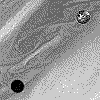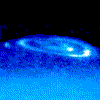Jupiter's Auroras
The black-and-white image on the left, taken in visible light, shows
how Io and Jupiter are linked by an invisible electrical current of charged
particles called a "flux tube." The particles - ejected from
Io (the bright spot on Jupiter's right) by volcanic eruptions - flow along
Jupiter's magnetic field lines, which thread through Io, to the planet's
north and south magnetic poles.
The black-and-white image on the right, taken in ultraviolet light,
shows Jupiter's auroral emissions at the north and south poles. Just outside
these emissions are the auroral spots, called "footprints".
The two ultraviolet false-color images reveal how the magnetic field
is offset from Jupiter's spin axis by 10 to 15 degrees.
|

